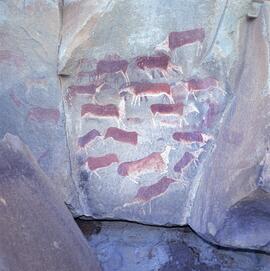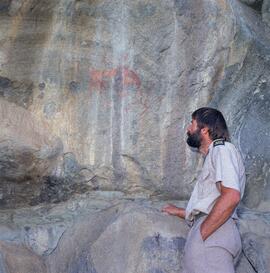Bundoran I 6103
195 Images & Collections results for Bundoran I 6103
195 results directly related
Exclude narrower terms
JHH JHH-NMSA-JHH-01-202H.jpg
·
Item
Part of Hone, John
The eland was the first animal that the San trickster deity, /Kaggen created and it remained his favourite.
The eland is the largest of southern African antelope and is much desired for its meat and fat. The San say that all other animals are like servants to the eland.
The importance of this animal is shown in the great variety of postures and perspectives. It is depicted running with tail outstretched, with uplifted head smelling the wind, and upside down, presumably dead. The eland is also depicted from the front or from the back, and even from above.
The eland appears in four important San rituals it is the most carefully depicted antelope in both rock paintings and engravings: Trance dance, boy's first kill, girl's puberty and marriage. It is believed that eland fat contains a lot of potency and in a trance dance shamans aspire to possess eland potency. Bundoran I 6103
JHH JHH-NMSA-JHH-01-203H.jpg
·
Item
Part of Hone, John
The eland was the first animal that the San trickster deity, /Kaggen created and it remained his favourite.
The eland is the largest of southern African antelope and is much desired for its meat and fat. The San say that all other animals are like servants to the eland.
The importance of this animal is shown in the great variety of postures and perspectives. It is depicted running with tail outstretched, with uplifted head smelling the wind, and upside down, presumably dead. The eland is also depicted from the front or from the back, and even from above.
The eland appears in four important San rituals it is the most carefully depicted antelope in both rock paintings and engravings: Trance dance, boy's first kill, girl's puberty and marriage. It is believed that eland fat contains a lot of potency and in a trance dance shamans aspire to possess eland potency. Bundoran I 6103
JHH JHH-NMSA-JHH-01-206H.jpg
·
Item
Part of Hone, John
Elephants are fairly frequently painted and engraved in certain regions.The paintings may be in red, black or white. Sometimes elephants are shown being hunted by a large party of men.
There are also therianthropes with elephant heads and trunks: it is thus possible that they were part of a shaman’s vision. According to the! Kung elephants have remarkable potency. Some of the most interesting paintings of elephants are in the Western Cape, and they are shown surrounded by zigzags and crenellated lines. Bundoran I 6103








